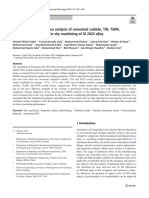0 ratings0% found this document useful (0 votes)
19 viewsHMT HT1 Lab Manual
HMT HT1 Lab Manual
Uploaded by
Iyan MehmoodCopyright:
© All Rights Reserved
Available Formats
Download as PDF or read online from Scribd
HMT HT1 Lab Manual
HMT HT1 Lab Manual
Uploaded by
Iyan Mehmood0 ratings0% found this document useful (0 votes)
19 views16 pagesCopyright
© © All Rights Reserved
Available Formats
PDF or read online from Scribd
Share this document
Did you find this document useful?
Is this content inappropriate?
Copyright:
© All Rights Reserved
Available Formats
Download as PDF or read online from Scribd
Download as pdf
0 ratings0% found this document useful (0 votes)
19 views16 pagesHMT HT1 Lab Manual
HMT HT1 Lab Manual
Uploaded by
Iyan MehmoodCopyright:
© All Rights Reserved
Available Formats
Download as PDF or read online from Scribd
Download as pdf
You are on page 1of 16
HT1_ HEAT CONDUCTION APPARATUS
EXPERIMENT A
OBJECT OF EXPERIMENT:
‘To investigate Foutier's Law for the linear conduction of heat along a simple bar.
EQUIPMENT SET-UP:
Temperature measurement
points at 10 mm rs
Brass sample
30mm long
Cor
1. When assembling the sample
between the heater and the
cooler take care to match the
shallow shoulders in the
Conducting compound
nylon housings. . at interfaces
2 Ensure that {he fel eiiperatire=s 4 sane
measurement points are
aligned along the
longitudinal axis of the unit.
SUMMARY OF THEORY:
bo If a plane wall of thickness (Ax).and area (A)
T+aT ak supports a temperature difference (AT) then the
p heat transfer rate per unit time (Q) by conduction
an through the wall is found to be:
4 Qe AAT
T dx
k
If the material of the wall is homogeneous and has a thermal conductivity (k) then:
egiggracire
-Al-
shoul iéd that heat flow 3S positive in the ection of temperature fall.
oe ‘sow i a
Tt should be'noted thal it the dire f
| and allow sufficient time
p i tion for the heater power contro!
Select an intermediate POSEN, crioved before recording Me temperate Ee
fora steady state condition (0 ower reading of the wattmeter (Q), | This,
nine sensor points, 206 ated for other input powers UP the maximum setting 0!
READINGS TO BE TAKEN:
rocedure shoul ra i .d to achieve steady state
the control. After each change, sufficient time must be allowet ly §
conditions.
RESULTS:
Tail Warmneter]T, |7]Ta]T4|T5["6|"7]F8]79] Pol — a
°c Joc foc foc J°c [°C °C ec Joc | temperature profile
NoMa <. along the length of the
vad note how is vis |) core will result in a
set of straight lines
B having approximately
at the same slope dT
Cc dx
L | a
tne c Alter dach cijnje, ilThis'slope may: be used. to determine the thermal »
1 t conductivity of brass:
2
f | RFQ a
5 A dt
& Appropriate multiplication factors should be
r a : introduced to convert the result to normally
joa || accepted, units for thermal conductivity.
. ie. W/mK
The result obtained should be comy i
of published data. pared to typical values for brass contained in tables
Students should comment upon the effec
ae 5 ct of average tem]
thermal conductivity ~ k increases with T for brass. Flow dees the face y yao ee
shape oF the temperature profile? 0 es the factor influence the
Note:
It is often necessary to evaluate th
\¢ heat floy i
steady e.g. through th ww through a
y eg, through the wall of a furnace that is being heated oy ten, he flow is Rot
distribution through the solid and hon ae co neces ind the, oe eeatie
equipment set-up already described, its 4
profile vaiatigg using either a heat |S 2.simple matter to
unsteady state conduction, \g Or cooling cycle thu;
ADL
wf
HT1 HEAT CONDUCTION APPARATUS
EXPERIMENT:
OBJECT OF EXPERIMENT:
To study the conduction of heat along a compo:
transfer coefficient.
site bar and evaluate the overall heat
EQUIPMENT SET-UP:
Temperature measurement
ints at 10. mm ers.
Cooler
tiiteh =| Heater
power, control
Temperature selector
Note: switch Core:
Stainless
fen 30 mm long
When assembling the sample
between the heater and the
cooler take care to match the
shallow shoulders in the nylon
housings.
25mm dia,
= Keonduéting )
HT1 HEAT CONDUCTION APPARATUS
EXPERIMENT E
OBJECT OF EXPERIMENT:
See 1 conduction between adjacent
slabs of material. surface contact on thermal
EQUIPMENT SET-UP: £5
Tmperture, menu
cooler
clamp
° 7
° i
ae acest
S| ie 1 wate
“oN switch | Heater ae ~~
power” contol
mmparaturepelector ”
Tas
JECT OF EXmieMEN
Notes: Core:
1, When assembling the sample
between the heater and the
cooler, take care to match the
shallow shoulders in the nylon
housing
Temperature (1! Vighimetor 1
fn Conducting
compound
2 Ensure that the temperature
measurement points are aligned inthis interface
along the longitudinal axis of cnly
the unit.
SUMMARY OF THEORY:
rae
When two surfaces are in contact, paths of
thermal conduction exist only across those points
where actual physical contact occurs on the
microscopic scale and the degree of thermal
contact depends on the respective surface finishes.
Air tapped’ in the*gaps between each surface acts as a thermal insulator resulting in a
temperature step in the conduction path. This can be reduced by the use of conducting
compound which fills the air spaces and provides improved. thermal contact.
-B-
READINGS TO BE TAKEN:
Setup the equipment as shown with conducting compound over one interface only. The
other interface should be clean and dry and traces of compound removed with acetone or
an equivalent solvent. Set the heater power control to maximum and allow sufficient
e conduction to be achieved before recording the
time for a steady stat : :
temperature (T) at all nine sensor points and the input power reading on the wattmeter
Q):
RESULTS:
wattmeter|T | | 13} | ™5| 1s [7 %
Qwatts | | °C ele}lec}ec}fec}{ ec] c
spINGS TO BE TAKEN:
a
Graphs should be care!
section of the a eee showing the temperature distribution along each
temperature drop will be et extrapolated to the various interfaces. A marked
with conducting compound will! 'VEdsacross the clean interface ‘whereas the interface
exhibit only a very minor temperature drop.
EXPERIMENT F
OBJECT OF EXPERIMENT:
To investigate the influence of thermal insulation upon the conduction of
heat between adjacent metals.
EQUIPMENT SET-U
Temperatura measurement
points at 10. mm cfs.
Cooler
—— reer
Te
femperature (7) Wattmater
{_@
= pee
“ON switeh Hei
ce
Temperature selector
awiteh
Paper or Cork disc
FOUIPMENT. SET-UP.
Notes: Core:
[2:01
HEATER § COOLER
1. Ensure insulating discs
are concentric with metal
bar.
2, Do not use conducting
“compound =. with
|S instilating diss. = =
SUMMARY OF THEORY:
Materials such as paper and cork have
very low thermal conductivity which
means that only a small amount of heat
will pass through the material even
though a.high” temperature difference
may exist across its two faces. Such
materials are known as__ thermal
insulators and are practically utilised in
situations where it is required to reduce
heat losses from a hot body to the
atmosphere.
Insulating mater
insuiatin
F-1
READINGS TO BE TAKEN: aper disc before clamping it between
thickness of the P* ximately 10-15 watts and
Using a micrometer measure the input power to approximal
the heater and cooler faces- Control the ations ‘whilst ensuring that T, does not
allow sufficient tine to reach St=B4Y °°, sensor points and the input power
exceed 150°C. Record the temperature whole procedure using the cork dse
reading on the wattmeter (Q) before repealing:
in place of the paper.
RESULTS:
‘Paper disc thickness = _™m_ 7
oe ° Plots of the temperature profile in the heater
and cooler should be extrapolated to the
Wattmeter |T; | T2|T3|T7|T3 |79 interfaces so as to determine the temperature
Qwatts_ feclecleclec|ecl:c’| gradient across the insulating disc. The
results may be used to determine the thermal
2 | conductivity of paper and cork:
b) Cork disc thickness
Wattmeter|T; [T|T3|T7|T|T | | _ Q
Qwatts [Pc}eclec |*c]°c ec AL 4T
| insulator
Note: If the maximum temperature is
allowed to rise above 100°C, a
thermostat will disconnect power to
heater giving inaccurate results.
i tt con
Appropriate multiplication factors sh i
all ‘i ‘ould be introduced to convert th sult to
reed accepted units for thermal conductivity i.e. W/m K. ae
‘The results obtained should be i
Ir abies of pabished date o mPated to typical values for paper and cork contained
Students should comm: i
‘ent upon the influence which insulators have upon the conduction
of heat between the heater and eer
Suggest practical w ir ating oa do these materials inhibit conduction?
-F2-
e
GENERAL SAFETY RULES
1
Follow Relevant Instructions
jefore attempting to install, commission or operate equipment, all
relevant suppliers/manufacturers instructions and local regulations
should be understood and implemented.
It is irresponsible and dangerous to misuse equipment or ignore
instructions, regulations or warnings.
Do not exceed specified maximum operating conditions (e.g.
temperature, pressure, speed etc.)
Installation
Use lifting tackle where possible to install heavy equipment. Where
2 lifting is necessary beware of strained backs and crushed toes.
Get help from an assistant if necessary. Wear safety shoes where
appropriate.
Pee reee care should be exercised to avoid damage to the equipment
during handling and unpacking. When using slings to lift equipment,
bisiiré that't "5 are attached to structural framework and do not
foul adjacent pipework, glassware etc. When using fork lift trucks,
position the forks beneath structural framework ensuring that the forks
Be not foul adjacent pipework, glassware etc. Damage may go unseen
during commissioning creating a potential hazard to subsequent
operators.
Where special foundations are required follow the instructions
ovided and do not improvise. Locate heavy equipment at low level.
fiipment involving inflammable or corrosive liquids should be sited in
sTontainment area or bund with a capacity 50% greater than the
maximum equipment contents.
Eneure that all services are compatible with the equipment and that
indepenideit idolators are always provided and labelled. Use reliable
connections in all instances, do not improvise.
Ensure that all equipment is reliably earthed and connected to an
J-supply.'atthe correct voltage. The electrical supply must
ssiporate"an Earth Leakage Circuit Breaker (ELCB) or ‘Residual
Current Circuit Breaker (RCCB) to protect the operator from severe
tlectric shock in the event of misuse or accident.
Sotential hazards should always be the first consideration when
deciding on’ Suitable location for equipment. Leave sufficient space
between equipment and between walls and equipment.
Commissioning: *
Equipment invaivine 19) :
Ensure that equipment is commissioned and checked by a competent
member of staff before permitting students to operate it.
Operation
Bi that students are fully aware of the potential hazards when
insure tha’
operating equipment ‘ etent member of staff at all
vised by a comp: .
Sem al ane nao In ome
ded.
e equi] ment sunatten< .
poe or Saedents to derive their own experimental procedures
they are com] etent to do so. ; :
ae oe can sult from touching apparently stationary equipment
‘When using a stroboscope t *freeze’ rotary motion.
Maintenance
Badly maintained equipment is a potential hazard. Ensure that a
‘competent member of staff is responsible for organising maintenance and
fepairs on a planned basis. i
Do not permit faulty equipment to be operated. Ensure that repairs are
cartied out competently and checked before students are permitted to =
operate the equipment.
Using Electricity
Re least tite’ eachmonth, check that ELCB's (RCCB's) are operating
wirectly by pressing the TEST button. The circuit breaker must trip
when the button is pressed (failure to trip means that the operator is not
protected and a repair must be effected by a competent electrician before
the equipment or electrical supply is used).
Electricity is the commonest cause of accidents in the laboratory. Ensure
that all members of staff and students respect it.
Encure’that-the electrical supply has been disconnected from the
équipmient before attempting repairs or adjustments. Ie
Water‘and electricity are not compatible and can cause serious
injury if they come into contact. Never operate portable electric
appliances adjacent to equipment involving water unless some form of
constraint or barrier is incorporated to prevent accidental contact.
Always disconnect equipment from the electrical supply when not inuse.
Avoiding fires or explosic
‘At leaut once cach monte é
‘Ensure that the laboratory is provided with adequate fire extinguishers
appropriate to the potential hazards.
Where inflammable liquids are used, smoking must be forbidden.
Notices should be displayed to enforce this.
Beware since fine powders or dust can spontaneously ignite under certain
conditions. Empty vessels having contained inflammable liquids can
contain vay eal
BaMer aes lode if ignited.
ue iinable liquids should be stored outside the
in Accordance’ with local regulations.
10
erage tanks on equipment should not be overfilled. All spillages
should be immediately cleaned. up, ‘carefully disposing of any
When eT cloths etc. Beware of slippery floors. :
lab liquids giving off inflammable vapours are handled in the
aboratory, the area should be ventilated by an ex-proof extraction
By Yents.on the equipment should be connected to the extraction
system:
Students should not be allowed to prepare mixtures for analysis or
other purpose without competent supervision.
Handling poisons, corrosive or toxic materials
Certain liquids essential to the operation of equipment, for example
mercury, are poisonous or can give off poisonous vapours. Wear
appropriate protective clothing when handling such substaness, Clean
up any spillage immediately and ventilate areas thoroughly using
extraction equipment. Beware of slippery floors.
Do not allow food to be brought into or consumed in the laboratory.
Never use chemical beakers as drinking vessels.
Where poisonous vapours are involved, smoking must be forbidden.
Notices should be displayed to enforce this.
Poisons and.very toxic materials must be kept in a locked cupboard or
vescnand checked regularly. Use of such substances should be
supervised.
When diluting concentrated acids and alkalis, the acid or alkali should
te added slowly to water while stirring. The reverse should never be
attempted.
Avoiding cuts and burns
Inekeury, ats pene
Take, careewhen handling sharp edged components. Do. not exert
iertue force on glass or fragile items.
Hot surfaces carinot in most cases be totally shielded and can produce
votre bums even when not ‘visibly hot. Use common sense and
think which parts of the equipment are likely to be hot.
Eye protection
‘Gogeles austibe.wom whenever there is a risk to the eyes. Risk may
SOB from powders, liquid splashes, vapours or splinters. Beware of
Gubris from fast moving air streams. Alkaline solutions are
particularly dangerous to the eyes.
Parr look directly at a strong source of ight such as a laser or Xenon
arc lamp. Ensure that equipment using such a source is positioned so
that passers-by cannot accidentally view the source or reflected ray.
Facilities for eye irrigation should always be available.
fake care wren fendi
fe
Ear protectors must be worn when operating noisy equipment.
Clothing
be worn in the laboratory. Loose garments can
. ing should
Suitable clothing show! rings on fingers
cause serious injury if caught in rotating machinery. Ties,
should be removed in these situations.
‘Additional protective clothing should be available for all members of
staff and students as appropriate.
Guards and safety devices
Guards and safety devices are installed on equipment to protect the
operator. The equipment must not be operated with such devices
et 1011
Safety valves, cut-outs or other safety devices will have been set to
protect the equipment. Interference with these devices may create a
potential hazard.
It is not possible to guard the operator against all contingencies. Use
common sense at all times when in the laboratory.
Before starting a rotating machine, make sure staff are aware how to
stop it in an emergency.
Eristit@'that'speed'control devices are always set at zero before starting
dquipticent! protect Ou 1
First aid
If an accident does occur in the laboratory it is essential that first aid
equipment is available and that the supervisor knows how touseit. +
A notice giving details of a proficient first-aider should be prominent!
displayéd. ly
‘So! SHodAist*- oP tHe "antidotes for'thé chemicals used in a particular
laboratory should be prominently displayed.
di>piayen.
5)
You might also like
- The Subtle Art of Not Giving a F*ck: A Counterintuitive Approach to Living a Good LifeFrom EverandThe Subtle Art of Not Giving a F*ck: A Counterintuitive Approach to Living a Good LifeRating: 4 out of 5 stars4/5 (5981)
- The Gifts of Imperfection: Let Go of Who You Think You're Supposed to Be and Embrace Who You AreFrom EverandThe Gifts of Imperfection: Let Go of Who You Think You're Supposed to Be and Embrace Who You AreRating: 4 out of 5 stars4/5 (1112)
- Never Split the Difference: Negotiating As If Your Life Depended On ItFrom EverandNever Split the Difference: Negotiating As If Your Life Depended On ItRating: 4.5 out of 5 stars4.5/5 (898)
- Grit: The Power of Passion and PerseveranceFrom EverandGrit: The Power of Passion and PerseveranceRating: 4 out of 5 stars4/5 (619)
- Hidden Figures: The American Dream and the Untold Story of the Black Women Mathematicians Who Helped Win the Space RaceFrom EverandHidden Figures: The American Dream and the Untold Story of the Black Women Mathematicians Who Helped Win the Space RaceRating: 4 out of 5 stars4/5 (932)
- Shoe Dog: A Memoir by the Creator of NikeFrom EverandShoe Dog: A Memoir by the Creator of NikeRating: 4.5 out of 5 stars4.5/5 (546)
- The Hard Thing About Hard Things: Building a Business When There Are No Easy AnswersFrom EverandThe Hard Thing About Hard Things: Building a Business When There Are No Easy AnswersRating: 4.5 out of 5 stars4.5/5 (356)
- Her Body and Other Parties: StoriesFrom EverandHer Body and Other Parties: StoriesRating: 4 out of 5 stars4/5 (831)
- Elon Musk: Tesla, SpaceX, and the Quest for a Fantastic FutureFrom EverandElon Musk: Tesla, SpaceX, and the Quest for a Fantastic FutureRating: 4.5 out of 5 stars4.5/5 (476)
- The Emperor of All Maladies: A Biography of CancerFrom EverandThe Emperor of All Maladies: A Biography of CancerRating: 4.5 out of 5 stars4.5/5 (275)
- The Little Book of Hygge: Danish Secrets to Happy LivingFrom EverandThe Little Book of Hygge: Danish Secrets to Happy LivingRating: 3.5 out of 5 stars3.5/5 (424)
- The World Is Flat 3.0: A Brief History of the Twenty-first CenturyFrom EverandThe World Is Flat 3.0: A Brief History of the Twenty-first CenturyRating: 3.5 out of 5 stars3.5/5 (2272)
- The Yellow House: A Memoir (2019 National Book Award Winner)From EverandThe Yellow House: A Memoir (2019 National Book Award Winner)Rating: 4 out of 5 stars4/5 (99)
- Devil in the Grove: Thurgood Marshall, the Groveland Boys, and the Dawn of a New AmericaFrom EverandDevil in the Grove: Thurgood Marshall, the Groveland Boys, and the Dawn of a New AmericaRating: 4.5 out of 5 stars4.5/5 (270)
- The Sympathizer: A Novel (Pulitzer Prize for Fiction)From EverandThe Sympathizer: A Novel (Pulitzer Prize for Fiction)Rating: 4.5 out of 5 stars4.5/5 (125)
- Team of Rivals: The Political Genius of Abraham LincolnFrom EverandTeam of Rivals: The Political Genius of Abraham LincolnRating: 4.5 out of 5 stars4.5/5 (235)
- A Heartbreaking Work Of Staggering Genius: A Memoir Based on a True StoryFrom EverandA Heartbreaking Work Of Staggering Genius: A Memoir Based on a True StoryRating: 3.5 out of 5 stars3.5/5 (232)
- On Fire: The (Burning) Case for a Green New DealFrom EverandOn Fire: The (Burning) Case for a Green New DealRating: 4 out of 5 stars4/5 (75)
- The Unwinding: An Inner History of the New AmericaFrom EverandThe Unwinding: An Inner History of the New AmericaRating: 4 out of 5 stars4/5 (45)
- HMT Week 5Document21 pagesHMT Week 5Iyan MehmoodNo ratings yet
- HMT Week 6Document28 pagesHMT Week 6Iyan MehmoodNo ratings yet
- CamScanner 10-26-2023 09.00Document7 pagesCamScanner 10-26-2023 09.00Iyan MehmoodNo ratings yet
- Comparative Performance Analysis of Different Coated and Un Coated ToolsDocument21 pagesComparative Performance Analysis of Different Coated and Un Coated ToolsIyan MehmoodNo ratings yet
- Binder 4Document5 pagesBinder 4Iyan MehmoodNo ratings yet













































